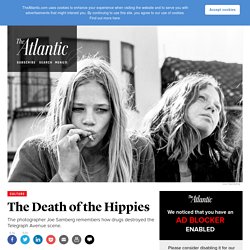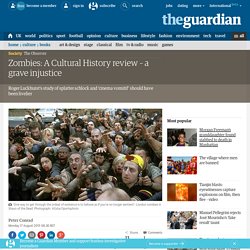

Beats, bucks and bling: the first stars of hip-hop – in pictures. The heart of darkness that still beats within our 24-hour cities. On some nights, in the insomniac intervals between rumbling goods trains, and beneath the sound of ambulance sirens, I can hear owls calling mournfully to one another from the trees that screen the railway tracks running past the back of the house in which I live in inner London.

The classic film posters of Saul Bass – in pictures. « La notion de vérité fait partie de nous » Né en 1939, Carlo Ginzburg a enseigné à Bologne, à Los Angeles (UCLA) et à l’École normale supérieure de Pise.

Parmi ses livres, traduits dans de nombreuses langues, on peut citer Le Fromage et les Vers (trad. française, 1980), Les Batailles nocturnes (1980), Le Sabbat des sorcières (1992), Rapports de force (2003), Le Fil et les Traces (2010) et Peur révérence terreur. Quatre essais d’iconographie politique (2013). Prise de vue et montage : Ariel Suhamy Transcription de l’entretien La Vie des Idées : La micro-histoire (ou microstoria) est née en Italie dans les années 1970.
Carlo Ginzburg : Un malentendu possible et assez répandu consiste à croire que la micro-histoire porte sur des personnages marginaux, des événements mineurs, etc. Mon livre Le Fromage et les Vers (1976), qui a parfois été considéré comme typique de la microstoria, a été écrit avant la théorisation de celle-ci.
The Death of the Hippies. In 1967, just after the Summer of Love, The Atlantic published “The Flowering of the Hippies,” a profile of San Francisco’s new youth culture.

“Almost the first point of interest about the hippies was that they were middle-class American children to the bone,” the author noted. “To citizens inclined to alarm this was the thing most maddening, that these were not Negroes disaffected by color or immigrants by strangeness but boys and girls with white skins from the right side of the economy ...
Y a-t-il encore des intellectuels de gauche ? ‘A rocket up the backside of conformity’ - how Allen Ginsberg’s Howl transformed pop. Sixty years ago this week, on 7 October 1955, Allen Ginsberg read Howl aloud for the first time, at the Six Gallery in San Francisco.

It’s a poem with many anniversaries – Ginsberg began writing it in mid-1954, and it wasn’t published until 1956 – which may be why Hal Willner organised a 60th-anniversary celebration of it at the Ace hotel in Los Angeles in April of this year, with a lineup including Courtney Love, Beth Orton, Devendra Banhart, Nick Cave, Macy Gray and Peaches. That lineup hints at just how Howl has permeated popular culture and, unlike almost any other piece of literature, helped shape music as it is today.
Right-wing 'new reactionaries' stir up trouble among French intellectuals. How John Peel created our musical world. It was 27 July 2012, the night of the opening ceremony of the Olympic Games.

The Queen got into a helicopter. Men with top hats walked on Glastonbury Tor. Toni Morrison on Primo Levi’s defiant humanism. The Complete Works of Primo Levi is far more than a welcome opportunity to re-evaluate and re-examine historical and contemporary plagues of systematic necrology; it becomes a brilliant deconstruction of malign forces.

The triumph of human identity and worth over the pathology of human destruction glows virtually everywhere in Levi’s writing. For a number of reasons, his works are singular amid the wealth of Holocaust literature. First is his language – infused as it is with references to and intimate knowledge of ancient and modern sources of philosophy, poetry and the figurative uses of scientific knowledge. Chasing the chariot: in search of the soul of English rugby. The selling of the Krays: how two mediocre criminals created their own legend. In 1965, David Bailey, already Britain’s most fashionable photographer, took a portrait of the gangster twins Ronnie and Reggie Kray, who looked fiercely well-groomed in suits and narrow ties.

At the time, they were not the notorious gangsters they were to become, but former boxers who ran nightclubs and collected protection money from people in awe of their reputation as a two-headed fighting machine. The portrait became gangland’s Mona Lisa: copied, pirated and imitated, it was central to their image and their brand. Debauchery and darkness: 30 years of drinking with Francis Bacon. Partying with Francis Bacon, as I often did over the 30 years we were friends, easily turned into a rollercoaster.

However sedately an outing began, over oysters at Wheeler’s or champagne at the Ritz, it always grew exuberant and often dangerous as the members-only drinking holes gave way to Soho clubs where Bacon bought drinks for everyone in sight and dominated the conversation with lengthy tirades about the futility of life. “We come from nothing and go into nothing,” he would repeat triumphantly, his champagne glass held high. After meeting Bacon in London in the early 1960s, when I interviewed him for a student magazine I was editing, I began seeing him regularly, as much for the interview as for the fun of being taken from grand hotel to seedy drinking den and meeting everyone in his orbit, from poets and pop stars to dukes and gangsters.
But luck was on my side. That same year he had his first, really important gallery show in Paris. I thought we were going to get thrown out. L’avant-garde situationniste : une analyse sociologique. Zombies: A Cultural History review – a grave injustice. “Almost everyone is a zombie now,” yawns a blasé teenager in one of Stephenie Meyer’s Twilight novels.

She is updating the heroine Bella – shortly to become a vampire’s virgin bride – on the progress of a horror film they are watching, but she might also be surveying the world outside the cinema. Are we surrounded by animated corpses, which lumpenly trudge along like the undead commuters on London Bridge in TS Eliot’s The Waste Land?
Study the queues for public transport in the rush hour or workers numbly performing menial tasks: one way to get through the ordeal of existence is to behave as if you’re no longer sentient. A little learning... Zydeco. That’s me in the picture: Hazel Whiskerd, protesting at Greenham Common, 1982. Iwas a child during the second world war and a young adult during the cold war.

I am 86 now, and I’ve never been able to live without the feeling that I might be annihilated at any minute. The blitz is romanticised now, but it was ghastly. Night after night we heard the bombs getting closer – after a while you became immune to it. 60 photos of the 1960s - readers' pictures. Pascal Ory, L’histoire culturelle ; Philippe Poirrier, Les enjeux de l’histoire culturelle.
L’histoire culturelle est d’abord le produit d’une demande sociale ; son succès auprès des contemporanéistes en atteste. Considérée comme un secteur en sous-développement en 1986 , elle s’installe dans les questions de l’agrégation d’histoire et dans les programmes du secondaire à partir de la fin des années 1980.
Son expansion agace, certains n’y voyant, comme François Bédarida, qu’une « tarte à la crème » ; pourtant, deux ans plus tard, Jean-Pierre Rioux et Jean-François Sirinelli observent la prolifération de l’adjectif « culturel » apposé sur tant de travaux historiques et expliquent cet intérêt des historiens par le contexte d’un siècle finissant dans lequel seule la culture créerait du lien et produirait du sens . Pascal Ory, L’histoire culturelle ; Philippe Poirrier, Les enjeux de l’histoire culturelle.
L’histoire culturelle est d’abord le produit d’une demande sociale ; son succès auprès des contemporanéistes en atteste.